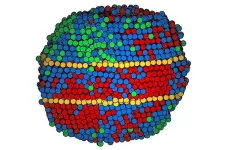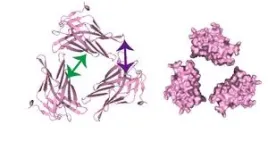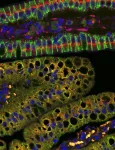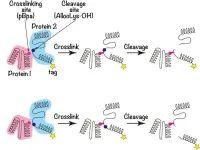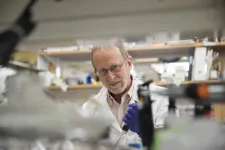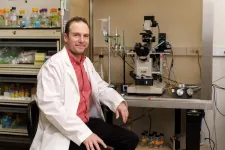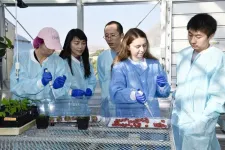(Press-News.org) Alloys, which are materials such as steel that are made by combining two or more metallic elements, are among the underpinnings of contemporary life. They are essential for buildings, transportation, appliances and tools — including, very likely, the device you are using to read this story. In applying alloys, engineers have faced an age-old trade-off common in most materials: Alloys that are hard tend to be brittle and break under strain, while those that are flexible under strain tend to dent easily.
Possibilities for sidestepping that trade-off arose about 20 years ago, when researchers first developed medium- and high-entropy alloys, stable materials that combine hardness and flexibility in a way in which conventional alloys do not. (The “entropy” in the name indicates how disorderly the mixture of the elements in the alloys is.)
Now, a UCLA-led research team has provided an unprecedented view of the structure and characteristics of medium- and high-entropy alloys. Using an advanced imaging technique, the team mapped, for the first time ever, the three-dimensional atomic coordinates of such alloys. In another scientific first for any material, the researchers correlated the mixture of elements with structural defects.
“Medium- and high-entropy alloys had been previously imaged at the atomic scale in 2D projections, but this study represents the first time that their 3D atomic order has been directly observed,” said corresponding author Jianwei “John” Miao, a professor of physics in the UCLA College and member of the California NanoSystems Institute at UCLA. “We found a new knob that can be turned to boost alloys’ toughness and flexibility.”
Medium-entropy alloys combine three or four metals in roughly equal amounts; high-entropy alloys combine five or more in the same way. In contrast, conventional alloys are mostly one metal with others intermixed in lower proportions. (Stainless steel, for example, can be three-quarters or more of iron.)
To understand the scientists’ findings, think of a blacksmith forging a sword. That work is guided by the counterintuitive fact that small structural defects actually make metals and alloys tougher. As the blacksmith repeatedly heats a soft, flexible metal bar until it glows and then quenches it in water, structural defects accrue that help turn the bar into an unyielding sword.
Miao and his colleagues focused on a type of structural defect called a twin boundary, which is understood to be a key factor in medium- and high-entropy alloys’ unique combination of toughness and flexibility. Twinning happens when strain causes one section of a crystal matrix to bend diagonally while the atoms around it remain in their original configuration, forming mirror images on either side of the boundary.
The researchers used an array of metals to make nanoparticles, so small they can be measured in billionths of a meter. Six medium-entropy alloy nanoparticles combined nickel, palladium and platinum. Four nanoparticles of a high-entropy alloy combined cobalt, nickel, ruthenium, rhodium, palladium, silver, iridium and platinum.
The process to create these alloys resembles an extreme — and extremely fast — version of the blacksmith’s task. The scientists liquified the metal at over 2,000 degrees Fahrenheit for five-hundredths of a second, then cooled it down in less than one-tenth that time. The idea is to fix the solid alloy in the same varied mixture of elements as a liquid. Along the way, the shock of the process induced twin boundaries in six of the 10 nanoparticles; four of those each had a pair of twins.
Identifying the defects required an imaging technique the researchers developed, called atomic electron tomography. The technique uses electrons because atomic-level details are much smaller than wavelengths of visible light. The resulting data can be mapped in 3D because multiple images are captured as a sample is rotated. Tuning atomic electron tomography to map the complex mixtures of metals was a painstaking endeavor.
“Our goal is to find the truth in nature, and our measurements have to be as accurate as possible,” said Miao, who is also deputy director of the STROBE National Science Foundation Science and Technology Center. “We worked slowly, pushing the limit to make each step of the process as perfect as possible, then moved on to the next step.”
The scientists mapped each atom in the medium-entropy alloy nanoparticles. Some of the metals in the high-entropy alloy were too similar in size for electron microscopy to differentiate among them. So the map of those nanoparticles grouped the atoms into three categories.
The researchers observed that the more that atoms of different elements (or different categories of elements) are mixed, the more likely the alloy’s structure will change in a way that contributes to matching toughness with flexibility. The findings could inform the design of medium- and high-entropy alloys with added durability and even unlock potential properties currently unseen in steel and other conventional alloys by engineering the mixture of certain elements.
“The problem with studying defective materials is that you have to look at each individual defect separately to really know how it affects the surrounding atoms,” said co-author Peter Ercius, a staff scientist at Lawrence Berkeley National Laboratory’s Molecular Foundry. “Atomic electron tomography is the only technique with the resolution to do that. It’s just amazing that we can see jumbled atomic arrangements at this scale inside such small objects.”
Miao and his colleagues are now developing a new imaging method that combines atomic electron microscopy with a technique for identifying a sample’s makeup based on the photons it emits, in order to distinguish between metals with atoms of similar size. They are also developing ways to examine bulk medium- and high-entropy alloys and to understand fundamental relationships between their structures and properties.
The study was published Dec. 20 in the journal Nature.
The co-first authors of the study are Saman Moniri, a former UCLA postdoctoral scholar; Yao Yang, who earned a doctorate from UCLA in 2021; and Jun Ding of Xi’an Jiaotong University in China. Other co-authors are UCLA postdoctoral scholars Yuxuan Liao; former UCLA postdoctoral scholars Yakun Yuan, Jihan Zhou, Long Yang and Fan Zhu; and Yonggang Yao and Liangbing Hu of University of Maryland, College Park.
The study was supported by the U.S. Department of Energy. The experiment was performed at Berkeley Lab’s Molecular Foundry, also sponsored by the DOE.
END
3D atomic details of next-generation alloys revealed for first time
UCLA-led team maps medium- and high-entropy alloys and identifies potential to tune their properties, making them both stronger and more flexible
2023-12-20
ELSE PRESS RELEASES FROM THIS DATE:
Catalyzing drug discovery with explainable deep learning
2023-12-20
Scientists have discovered one of the first new classes of antibiotics identified in the past 60 years, and the first discovered leveraging an AI-powered platform built around explainable deep learning.
Published in Nature today, the peer-reviewed paper, entitled “Discovery of a structural class of antibiotics with explainable deep learning,” was co-authored by a team of 21 researchers, led by Felix Wong, Ph.D., co-founder of Integrated Biosciences, and James J. Collins, Ph.D., Termeer Professor of Medical Engineering ...
Study unveils a role of mitochondria in dietary fat processing
2023-12-20
The maintenance of a balanced lipid homeostasis is critical for our health. While consumption of excessive amounts of fatty foods contributes to metabolic diseases such as obesity and atherosclerosis, fat is an indispensable component of our diet. Digested lipids supply the body with essential building blocks and facilitate the absorption of important vitamins. In a new study published in the journal Nature, a team of researchers led by Professor Manolis Pasparakis and their collaborators Professor Aleksandra Trifunovic and Professor Christian Frezza at the Excellence Cluster CECAD of the University of Cologne, and Professor Jörg Heeren ...
Protein secrets unveiled: Newl molecular insight of protein–protein interactions
2023-12-20
Researchers from Tokyo Medical and Dental University (TMDU) have developed a new technique allowing the binding interfaces on two interacting proteins to be characterized, and validated it by describing the homophilic interaction between LAMP2A molecules
Tokyo, Japan – Proteins are building blocks of our bodies, but they do not work solo. They form partners to facilitate in different biological processes that keep us going. However, analyzing how proteins interact at a molecular level can be challenging. Now, a research team from Japan reveals the secrets behind these “protein partnerships”.
In a study published recently in Protein Science, researchers ...
Alzheimer’s discovery reveals dire effect of toxic tau protein on brain cells
2023-12-20
University of Virginia Alzheimer’s researchers have discovered how harmful tau proteins damage the essential operating instructions for our brain cells, a finding which could lead to new treatments.
The toxic protein, the researchers found, warps the shape of the nuclei of nerve cells, or neurons. This alters the function of genes contained inside and reprograms the cells to make more tau.
While the protein has long been a prime suspect in Alzheimer’s and other neurodegenerative “tauopathies,” the new research from UVA’s ...
Fraunhofer USA releases Annual Research Report, Focus 2023
2023-12-20
Fraunhofer USA, a leading nonprofit research organization dedicated to applied research and development services, is proud to announce the release of its Annual Report, Focus 2023. The report underscores Fraunhofer USA's commitment to fostering transatlantic collaboration, strengthening university-government partnerships, and driving impactful technology transfer.
Transatlantic Collaboration: A Pillar of Innovation
In the pursuit of global innovation, Fraunhofer USA continues to play a pivotal role in fostering transatlantic collaboration. The annual report highlights the organization's successful partnerships with Fraunhofer-Gesellschaft research institutes, resulting in groundbreaking ...
International collaboration to improve cancer care in Sub-Saharan Africa updates resources for sixth year
2023-12-20
PLYMOUTH MEETING, PA [December 20, 2023] — The National Comprehensive Cancer Network® (NCCN®)—an alliance of leading academic cancer centers in the United States—is celebrating six years of working alongside the African Cancer Coalition (ACC), the American Cancer Society (ACS), and the Clinton Health Access Initiative (CHAI), as part of Allied Against Cancer. The collaboration was formed to support and empower the Sub-Saharan African oncology community to advance health system capacity, ...
New study sheds light on the connection between the microbiome and kidney stones
2023-12-20
A new study from Lawson Health Research Institute and Western University published in the journal Microbiome has found changes in the microbiome in multiple locations in the body are linked to the formation of kidney stones.
The human microbiome comprises trillions of microorganisms, including healthy bacteria. In recent years, research has begun to uncover its role in health and numerous diseases.
The research team examined the gut, urinary and salivary microbiomes in 83 patients who had kidney stones ...
TTUHSC researcher studies the ability of brine shrimp to thrive in high salinity
2023-12-20
Brine shrimp of the genus Artemia are small crustaceans that can thrive in environments where sodium concentrations are as high as 25% (more than eight times typical ocean sea water). Also known by the household pet trademark ‘sea monkeys,’ these animals are abundant in inland salt lakes where brine-fly larvae are the only other animals known to exist.
The mechanisms which permit brine shrimp to tolerate some of the harshest environments are only partially understood. Previously known adaptive features include a tight protective layer (integument) to avoid water loss and the increased extrusion of sodium (Na+) and chloride (Cl-) ions ...
Digital training program improves quality of life for care residents with dementia – even during the COVID-19 pandemic
2023-12-20
Quality of life for people with dementia living in residential and nursing home care substantially improved after staff took part in a digital training programme that was specially adapted to Covid-19 restrictions. The training also led to a significant drop in the prescription of potentially harmful sedative medications to residents.
The iWHELD programme supported care home staff in delivering personalised care and encouraging meaningful social interactions. Through a digital platform featuring live coaching sessions led by trained coaches, the programme supported ...
Discovery: Plants use “trojan horse” to fight mold invasions
2023-12-20
UC Riverside scientists have discovered a stealth molecular weapon that plants use to attack the cells of invading gray mold.
If you’ve ever seen a fuzzy piece of fruit in your fridge, you’ve seen gray mold. It is an aggressive fungus that infects more than 1,400 different plant species: almost all fruits, vegetables, and many flowers. It is the second most damaging fungus for food crops in the world, causing billions in annual crop losses.
A new paper in the journal Cell Host & Microbe describes how plants send tiny, innocuous-seeming lipid “bubbles” filled with RNA across enemy lines, into the cells of the aggressive mold. Once ...
LAST 30 PRESS RELEASES:
Bottleneck in hydrogen distribution jeopardises billions in clean energy
Lung cancer death rates among women in Europe are finally levelling off
Scientists trace microplastics in fertilizer from fields to the beach
The Lancet Obstetrics, Gynecology, & Women’s Health: Taking paracetamol during pregnancy does not increase risk of autism, ADHD or intellectual disabilities, confirms new gold-standard evidence review
Taking paracetamol during pregnancy does not increase risk of autism, ADHD or intellectual disabilities
Harm reduction vending machines in New York State expand access to overdose treatment and drug test strips, UB studies confirm
University of Phoenix releases white paper on Credit for Prior Learning as a catalyst for internal mobility and retention
Canada losing track of salmon health as climate and industrial threats mount
Molecular sieve-confined Pt-FeOx catalysts achieve highly efficient reversible hydrogen cycle of methylcyclohexane-toluene
Investment in farm productivity tools key to reducing greenhouse gas
New review highlights electrochemical pathways to recover uranium from wastewater and seawater
Hidden pollutants in shale gas development raise environmental concerns, new review finds
Discarded cigarette butts transformed into high performance energy storage materials
Researchers highlight role of alternative RNA splicing in schizophrenia
NTU Singapore scientists find new way to disarm antibiotic-resistant bacteria and restore healing in chronic wounds
Research suggests nationwide racial bias in media reporting on gun violence
Revealing the cell’s nanocourier at work
Health impacts of nursing home staffing
Public views about opioid overdose and people with opioid use disorder
Age-related changes in sperm DNA may play a role in autism risk
Ambitious model fails to explain near-death experiences, experts say
Multifaceted effects of inward foreign direct investment on new venture creation
Exploring mutations that spontaneously switch on a key brain cell receptor
Two-step genome editing enables the creation of full-length humanized mouse models
Pusan National University researchers develop light-activated tissue adhesive patch for rapid, watertight neurosurgical sealing
Study finds so-called super agers tend to have at least two key genetic advantages
Brain stimulation device cleared for ADHD in the US is overall safe but ineffective
Scientists discover natural ‘brake’ that could stop harmful inflammation
Tougher solid electrolyte advances long-sought lithium metal batteries
Experts provide policy roadmap to reduce dementia risk
[Press-News.org] 3D atomic details of next-generation alloys revealed for first timeUCLA-led team maps medium- and high-entropy alloys and identifies potential to tune their properties, making them both stronger and more flexible
